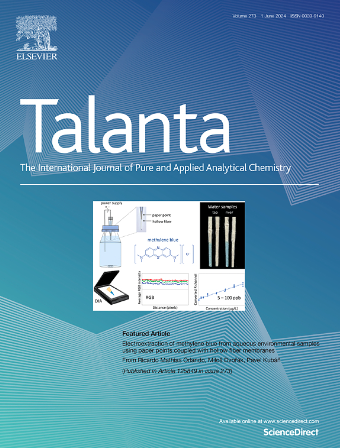Au NUs@SiO2 sensors for sensitive and selective optical sensing of volatile compounds
IF 5.6
1区 化学
Q1 CHEMISTRY, ANALYTICAL
引用次数: 0
Abstract
Plasmonic sensors has been widely used to detect the refractive index change in liquids, while it is challenging to apply the plasmonic sensors to the selective detection of organic vapors that adsorb non-specifically and induce extremely low refractive index change. Herein, silica shell was directly grown on Au nano-urchins (Au NUs) through sol-gel hydrolysis method to improve its vapor molecules anchoring capability and generate the selectivity to different vapors. According to the vapor sensing experiments to ethanol, acetone and hexane, the refractive index sensitivity (RIS) of Au NUs@SiO2 sensors was four times higher than that of bare Au NUs. In addition, Au NUs@SiO2 sensors demonstrate different vapor sensing performance to different organic vapors. The sensing characteristics is attributed to the large contacting area and the affinity between Au NUs@SiO2 sensors and the target molecules. These findings provide a basis for the development of novel plasmonic sensors and the RIS enhancement, which abroad their application as contactless sensors.

Au NUs@SiO2传感器,用于挥发性化合物的敏感和选择性光学传感
等离子体传感器已被广泛用于检测液体的折射率变化,但将等离子体传感器应用于非特异性吸附和极低折射率变化的有机蒸气的选择性检测是一个挑战。本文通过溶胶-凝胶水解法将二氧化硅壳直接生长在金纳米海胆(Au NUs)上,提高其蒸汽分子锚定能力,并对不同的蒸汽产生选择性。对乙醇、丙酮和己烷的气敏实验表明,Au NUs@SiO2传感器的折射率灵敏度(RIS)是裸Au NUs的4倍。此外,Au NUs@SiO2传感器对不同的有机蒸汽表现出不同的气敏性能。该传感特性归因于Au NUs@SiO2传感器与目标分子之间的大接触面积和亲和力。这些发现为新型等离子体传感器的发展和RIS的增强提供了基础,从而促进了它们在非接触式传感器中的应用。
本文章由计算机程序翻译,如有差异,请以英文原文为准。
求助全文
约1分钟内获得全文
求助全文
来源期刊

Talanta
化学-分析化学
CiteScore
12.30
自引率
4.90%
发文量
861
审稿时长
29 days
期刊介绍:
Talanta provides a forum for the publication of original research papers, short communications, and critical reviews in all branches of pure and applied analytical chemistry. Papers are evaluated based on established guidelines, including the fundamental nature of the study, scientific novelty, substantial improvement or advantage over existing technology or methods, and demonstrated analytical applicability. Original research papers on fundamental studies, and on novel sensor and instrumentation developments, are encouraged. Novel or improved applications in areas such as clinical and biological chemistry, environmental analysis, geochemistry, materials science and engineering, and analytical platforms for omics development are welcome.
Analytical performance of methods should be determined, including interference and matrix effects, and methods should be validated by comparison with a standard method, or analysis of a certified reference material. Simple spiking recoveries may not be sufficient. The developed method should especially comprise information on selectivity, sensitivity, detection limits, accuracy, and reliability. However, applying official validation or robustness studies to a routine method or technique does not necessarily constitute novelty. Proper statistical treatment of the data should be provided. Relevant literature should be cited, including related publications by the authors, and authors should discuss how their proposed methodology compares with previously reported methods.
 求助内容:
求助内容: 应助结果提醒方式:
应助结果提醒方式:


